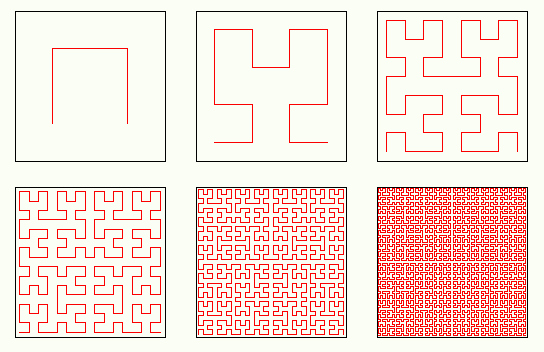101. What is a fractal?
Introduction
As these words by the esteemed Mandelbrot himself suggest there is a whole lot more to the world around us than what our present mathematical capabilities can truly capture. It has been rather clear for a few millennia now that ideal mathematical shapes and their perfect geometries are something that exist only within the confines of our inner mental worlds. All the physical objects we observe in our shared outer world at best approximate these ideal shapes and at worst are completely beyond their descriptive reach. This shouldn't be all that surprising though. With the exception of a handful of elementary particles everything else in our physical world is a composite — a large whole composed of many smaller things. This inevitably makes the physical world rather complicated, at least on our everyday macroscopic scale.
Consider yourself. In biological terms you are a symbiosis of various specialized organs which together conspire to keep the whole alive and functioning. You and your organs are made out of about two-hundred different kinds of cells, thirty trillion of them in total. Over a million different types of proteins carrying out their specific tasks are needed to make these cells function, but then somewhat surprisingly all of these proteins are made out of just twenty-two different amino acids. These organic molecules that serve as the building blocks of all known life are themselves made out mostly of carbon, hydrogen, oxygen, and nitrogen. All in all, the human body is composed of only forty-one different atoms for a total of about seven thousand trillion trillion of them. That's 7'000'000'000'000'000'000'000'000'000 all written out. Let's not even get started with what the atoms themselves are made of!
And that is just a snapshot description of a single instant of you. Without the myriad unceasing interactions going on between your cells, their proteins, and their constituent atoms you'd be no more alive than a chunk of rock. Indeed, without that last one nothing could even become chunky. There's also quite a lot of history that needed to happen for things to be the way they are now. Behind every single living thing there is an unbroken chain of genetic reproduction/recombination and mutation that goes back to the very beginning of life on Earth as we know it. That's about four billion years worth of evolution that went into developing the genes you carry in your DNA. In addition to that, there's the ten billion years of stellar evolution that had to happen in order to produce the elements that make up the life-supporting amino acids. In the biggest possible picture everything is connected.
All of this is a long-winded way of saying why physical things are necessarily complicated. Everything that exists in the physical universe comes with a lot of historical baggage that is often hand-waved or discretized away for us to be able to say anything meaningful at all. Exhaustively describing the composition and interactions of anything much larger than a subatomic particle is practically impossible quite simply because the space of possibilities is so unfathomably large. Which is in stark contrast to something like an ideal circle which can be perfectly described by just a single number. This informational disparity need not demoralize us however. Although we don't quite have the vocabulary to fully describe the geometrical shape of lightning or the fluffiness of clouds at least we have a pretty good understanding of the underlying physical laws that govern them.
Getting on with it
So what are fractals? As alluded to earlier, fractals are quite different from straight lines and perfect circles. Unlike the ideal geometric shapes they are not neatly defined by fixed properties such as angles, radius, or length. Instead, they are typically defined by the self-referential rules that are used to generate them. Even seemingly simple rules can lead to otherwise indescribable complexity as long as the rule is applied in a recursive fashion. Self-interaction seems to be the special ingredient that is needed to produce emergent complexity not explicitly encoded for in the rules being applied. This seems to be the case both in the fractal world and in our physical world (feedback is recursion). What eventually results from these recursive fractal rules are shapes and geometries that would probably offend anyone with a classical geometric disposition.
Two important words are often thrown around when fractals are being discussed: self-similarity and roughness. The first word should be fairly self-explanatory. It simply means that any whole can be split into smaller parts which will nonetheless keep resembling the unsplit sum. In the domain of mathematics where practical limitations need not slow us down this self-similarity can extend all the way to infinity, meaning that no matter how infinitesimally small the parts get they will always share a certain family resemblance with the overall fractal shape they are embedded in. It is important to keep in mind however, that while there are many self-similar fractals, not all fractals are self-similar. Roughness is more fundamental for fractals.
Roughness in this context is used in a strictly mathematical sense: it is the opposite of smooth. Mathematicians tend to like their functions smooth because it allows them to use a whole arsenal of different mathematical tools which have been developed and perfected over centuries and millennia (like calculus and differential geometry). Unfortunately, once the going gets mathematically rough practically all of these tools become largely inapplicable. If you take a random polynomial function and zoom in on a part of it you will find that it will eventually start to resemble a straight line. As long as there are no discontinuities or sharp corners in a function it is considered to be differentiable, and we have the means to calculate its derivative. However, fractal curves are different. Due to the infinitely recursive nature of fractals no matter how far you zoom in they will always appear just as jagged as before (if not more so) and will never smooth out into nice differentiable straight lines. Not only do we not know how to calculate derivatives for such curves, but the whole concept and its premise ceases to apply!
In describing the images and videos on this site as fractals I use the word somewhat loosely as it applies more to some images than others. The more comprehensive label would be "iterated function system" (or IFS) fractals. But in any case, all of them are merely finite representations of various infinitely recursive mathematical constructs. Most of them exhibit the characteristic roughness of fractals and some may appear self-similar to some degree. However, just like ideal shapes, ideal fractals do not exist in the physical (or digital) world since certain practical limitations get in the way sooner rather than later. It is perhaps for this reason that I feel it would be rather narrow-minded to restrict the usage of the word fractal strictly into the domain of mathematical perfection.
After all, there are plenty of real world phenomena which exhibit fractal-like behavior: the clouds, mountains, coastlines, bark, and lightning mentioned in the opening quote are all prime examples. As is Romanesco broccoli, the cardiovascular system of the human body, and the large-scale structure of the Universe. Even though the roughness and the self-similarities of real world objects are not as exact nor as infinite as they are in the field of abstract mathematics, all things considered our Universe and many things within it (with the notable exception of human-made objects) sure seem more fractal than not. Although a lot of this comes down to how we measure roughness and how we define similarity. A single water molecule suspended in air doesn't have much in common with a thundercloud, but if you squint your eyes just right it might pass for a very tiny cloud.
Going gets rough
In the domain of mathematics there is a special measure for roughness (named after the German mathematician Felix Haussdorf). Undoubtedly the concept of non-integer fractal dimensions probably seems rather counter-intuitive at first. You are probably accustomed to thinking of lines as being one-dimensional, squares as being two-dimensional, and cubes as being three-dimensional. You may have even heard of the four-dimensional space-time that permeates the whole Universe. But this nice and discrete dimensional framework seems to leave no room for anything inbetween — what could possibly be considered 1.5-dimensional?
This video by Grant Sanderson (aka 3Blue1Brown) gives a marvelous explanation as to how fractal dimensions work and I will not attempt to replicate the full explanation here. Instead to summarize, suppose you have in your possession a sufficiently long strand of an infinitely thin wire which you can easily bend and stretch to any shape you desire. Provided you follow the recursive bending pattern suggested by the image below your one-dimensional wire will begin to more and more closely resemble a two-dimensional square. In a practical (and therefore finite) situation the bent wire will always be revealed to be smoothly one-dimensional under sufficient magnification. However, in the abstract infinite case the recursively bent and infinitely long wire will successfully transform into a solid two-dimensional square.
The curve is thus space-filling which is exactly what it sounds like. The original single dimension becomes so deformed that it manages to occupy the entirety of a two-dimensional shape, without any gaps. The counter-intuitive consequence is that this makes it possible to describe the location of each point within the square with just a single coordinate number instead of the usual two. We can also imagine analogous bending patterns that manage to fill up even higher dimensions (which has been used to great effect in the field of computer science). Thanks to its space-filling nature the Hilbert curve can be said to have a fractal dimension of two while its topological dimension is one — it is at the same time both a plane and a line.
Now consider the coastline of the United Kingdom. As the name would seem to suggest the coast is in the last analysis a one-dimensional line. However, any map will show you that coastlines tend to be very jagged (some more than others). They can never be quite as wiggly as the Hilbert curve, but neither are they as smooth as ideal lines. Coastlines (and other shapes) occupy the dimensional middle ground which exists between the more familiar integer dimensions. In this sense the coastline of the United Kingdom can be said to have a fractal dimension of about 1.25. That is, provided we don't look too closely. Once we can make out the individual grains of beach sand the coast (formerly known as a line) becomes a discontinuous collection of three-dimensional molecules.
At first extending the concept of dimensionality in this way may seem non-sensical and you would certainly not be alone in thinking so. Consider some analogues: when we double the side lengths of a two-dimensional square its area ends up quadrupling, and likewise, when we double the side lengths of a three-dimensional cube its volume increases eightfold. By changing the side lengths we are effectively scaling the objects which is reflected in their higher-dimensional measurements — such as area and volume. For a fractal object like a coastline, scaling it up by a factor of two makes its 1.25-dimensional measurement grow by approximately 2.38 (two to the power of 1.25). Unfortunately human languages offer us no easy words for such fractal measurements.
TL;DR
In the end the question is perhaps best answered loosely in the following way: fractals are the categorical counterpart of everything straight and flat and smooth — the roughly fractional situated between the idealized integral dimensions. While they can exhibit a certain degree of self-similarity at varying scales not all fractals are self-similar. This loose definition should work well enough for all our non-serious intents and purposes. With the philosophical side of fractals out of the way we can start to consider their more practical aspects in the next part on ► How to draw fractals?








